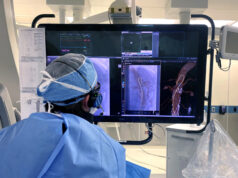
A new study suggests that a novel skin dose-tracking system (Toshiba) may reduce radiation exposure in patients undergoing percutaneous coronary intervention (PCI). However, the system was not found to reduce radiation exposure in patients undergoing coronary angiography.
Writing in Catheterization and Cardiovascular Interventions, Eiji Ichimoto (Department of Invasive Cardiology, Englewood Hospital and Medical Center, Englewood, USA) and others report that the dose-tracking system is designed to facilitate the management of peak skin dose. They note the system “has a real-time radiation skin dose monitor displaying a colour graphic”, adding: “The skin dose distribution map on the realistic patient graphic can manage peak skin dose and reduce the risk the risk of deterministic injury. Moreover, the operator can confirm peak skin dose of radiation during cardiac catheterisation.”
The system, Ichimoto et al note, was introduced at their centre in February 2015 (and has been used in all cases since then; therefore, they compared patient radiation dose (via reference air kerma) in those who had undergone coronary angiography/coronary angiography and PCI with the system with those who had undergone such procedures without the system. “The present study used reference air kerma as the primary endpoint. As for the reason for that, kerma air product is generally considered a poorer indication of patient skin dose as compared to reference air kerma,” the authors comment.
While the dose-tracking system was not associated with a reduction in radiation exposure in patients undergoing coronary angiography alone, reference air kerma was significantly reduced in patients undergoing PCI with the system (56)—204.6±141.1mGy vs. 294.2±237.4mGy for patients undergoing PCI without the system (57); p=0.016—as was kerma air product. Ichimoto et al write: “Multiple regression analysis showed increased reference air kerma during PCI was associated with male gender, body mass index, and American Heart Association/American College of Cardiology type B2 or C lesions. Conversely, the dose-tracking system correlated with decreased reference air kerma during PCI (p=0.007).”
However, use of the dose-tracking system was not associated with reductions in fluoroscopic or procedure times. The authors report: “For this reason, the number of cine runs in PCI with dose-tracking system group was reduced though the strategy of PCI was the same. The dose-tracking system displayed in real-time as a 3D colour map on human graphics, can immediately feedback to the operator of PCI.” They add that by being able to confirm peak skin dose of radiation by visualisation during PCI, the operator can use the system to “facilitate the management of peak skin dose and reduce of the risk of deterministic injury by avoiding areas approaching skin dose thresholds.”












